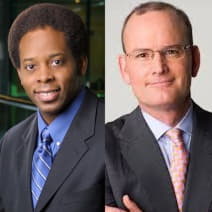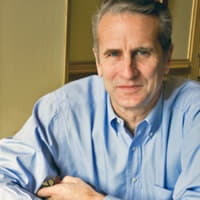
Tom Wilcox
Click here for Part I, Part II & Part III
Tom Wilcox, 69, will step down from the Baltimore Community Foundation at the end of the year, after 17 years at the helm of the umbrella philanthropic organization that brings together scores of donors and millions of dollars for the welfare of Greater Baltimore.
When Wilcox assumed leadership of the BCF, it gave out grants of $5 million annually. As he readies to exit, that number has grown five-fold to $25 million, while the endowment at its command is inching toward $200 million.
In an interview with DLA Piper’s
Guy Flynn and former Legg Mason CEO Mark Fetting, Wilcox recounts his distinguished stint at the head of “a philanthropic bank,” after nearly two decades in education as head of Concord Academy. “Baltimore boasts of a growing economy, in which all have the opportunity to thrive. It’s about merging economic development with poverty reduction, so that all boats go up, and particularly those people who aren’t yet even swimming necessarily can be fully floating and moving forward,” Wilcox said.
Flynn, a lawyer, is a member of the five-person Baltimore City Board of Ethics and a past chairman of the Maryland State Bar Association’s Real Property Section Discussion Group. Fetting is associated with a variety of charitable and philanthropic work and headed United Way of Central Maryland’s fundraising campaign in 2013.
GUY FLYNN: There are three main categories to the foundation’s work – philanthropic services, strategic grant-making and civic leadership. Let us talk about each of these. First, how about the philanthropic service’s side.
TOM WILCOX: Philanthropic services basically are that our staff becomes staff to the thousands of people who give through or to BCF annually. A lot of the services that are, say, available to Abell Foundation or other places to them and what they do, and so we have people and what we call donor services who work directly with these donors and who also administer online activity for them. So, people can go online and see the status of their fund, make grants from it and then we also convene families who run their goals and help them to establish goals. So, it really is a built-in partner with the donor.
GUY FLYNN: And that would include examples like the Women’s Giving Circle, the Baker Fund, the Stulman Fund…
TOM WILCOX: Each of them has a different kind of relationship with BCF. The Women’s Giving Circle is a fund of the Walmart Community Foundation. It does its work through and with us, and we established it with Pam Corckran and Shelley Goldsecker 17 years ago as we gave them $10,000 to get things going and they then used their magic to build this thing to what is now 450, almost 500 members who give away half a million dollars annually to women and their families in Baltimore through an extraordinary organic viral process. They were doing viral marketing long before anyone knew what it was and so we’re the office backbone for that. It has its own life and once again, it is one of the credos of Wally Pinkard, my first chair. It is amazing what you can get done and you do not need to take credit for it. So, we are a kind of hidden backbone behind the Giving Circle…The Healthy Neighborhoods, all these others, people know about them but they do not know that we actually started it, made it happen for many years, housed it.
The Stulman Foundation and the Baker Fund are actually not technically part of BCF, but we have a bigger impact upon them than we do with many of our funds here. The Baker Fund, we have served for 35 years and in the last 10, have helped them focus down into arts, using the arts as a way to build Baltimore’s economy, attracting artists, strengthening culture opportunities in Baltimore and celebrating our artists in really some fascinating ways.
The Stulman Foundation is a $100 million foundation that does all of its grant-making through us in aging and mental health. So, we cannot claim it as an asset, but the $4.5 million-$5 million a year that they give away happens because of great work done by us and by our contractors. So we serve philanthropy in a variety of ways.
GUY FLYNN: A second important part of the mission is strategic grant-making and they, kind of, talk about how you leverage BCF’s investments for impact?
TOM WILCOX: Well, that is a great question. Leverage really is what it is all about. It is that we are able to take discretionary income from our endowment and use it to leverage both pragmatic change in Baltimore and many, many, many dollars to make it all happen. I cited Healthy Neighborhoods in the hundreds of millions of dollars a day that they were able to generate. The same thing held true with our Middle Grades Partnership, less than $100 million is generated, $20 million with you name it, the transportation alliance, $500,000 is generated.
GUY FLYNN: What about Judy Centers?
TOM WILCOX: Judy Centers is an extraordinary opportunity for us to leverage $6 million in private sector grant-making, $18 million in public sector initiatives and countless dollars because the public sector is going to pick up this funding going forward. So, we like to say that we have a 50 to 200 times return on philanthropic investment and making a difference. It is also as much about leveraging public change because we use our voice to be able to make things happen at City Hall, in Annapolis and even with the federal government.
Connect with Tom on LinkedIn

Flynn, a lawyer, is a member of the five-person Baltimore City Board of Ethics and a past chairman of the Maryland State Bar Association’s Real Property Section Discussion Group. Fetting is associated with a variety of charitable and philanthropic work and headed United Way of Central Maryland’s fundraising campaign in 2013.


Edwin Warfield, CEO of citybizlist, conducts the CEO Interviews.
If you're interested in reaching CEOs, please contact edwin.warfield@citybuzz.co
Connect on LinkedIn


































